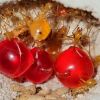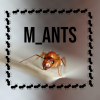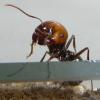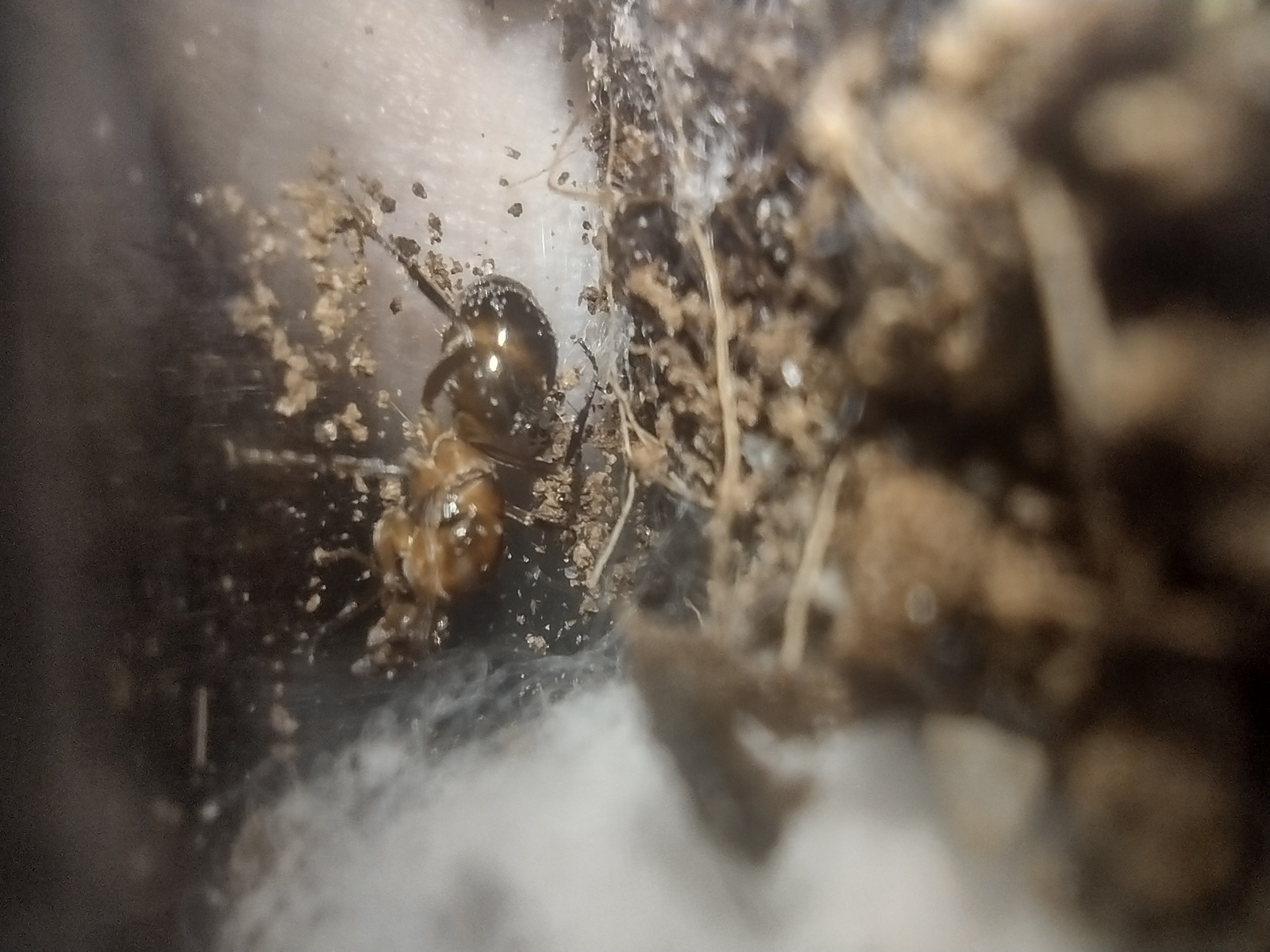- Formiculture.com
- Forums
- Gallery
- Members
- Member Map
- Chat
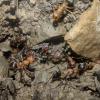
Ant recovery journals.
Started By
Virginian_ants
, Sep 10 2023 4:22 PM
9 replies to this topic
#1
 Offline
-
Posted September 10 2023 - 4:22 PM
Offline
-
Posted September 10 2023 - 4:22 PM
This journal is for anyone that has a ant colony a disease and how they recovered.
I'll go first. My little brother has an Aphaenogaster colony that was doing great, but in early June they got mysterious sick and lost 90% of their workers. We went in a took the queen, 5 workers, and some brood out and into a test tube. They weren't eating so he brood boosted them with ~15 pupae now they have exploded in growth and are doing well.
I currently have a Formica incerta queen that is covered in mites. They aren't the blood sucking type but her one and only larvae died after she got them so I moved her into a soil setup with a piece of egg carton covered in soil I put her in and she went into the cartoon and is going to stay there until she recovers. This hopefully will give the mites a place to drop off. The mites hold on for the hope the ant will move to suitable place for the mites to live. I will update this periodically.
Post your stories as well.
I'll go first. My little brother has an Aphaenogaster colony that was doing great, but in early June they got mysterious sick and lost 90% of their workers. We went in a took the queen, 5 workers, and some brood out and into a test tube. They weren't eating so he brood boosted them with ~15 pupae now they have exploded in growth and are doing well.
I currently have a Formica incerta queen that is covered in mites. They aren't the blood sucking type but her one and only larvae died after she got them so I moved her into a soil setup with a piece of egg carton covered in soil I put her in and she went into the cartoon and is going to stay there until she recovers. This hopefully will give the mites a place to drop off. The mites hold on for the hope the ant will move to suitable place for the mites to live. I will update this periodically.
Post your stories as well.
- bmb1bee and Ernteameise like this
#2
 Offline
-
Posted September 10 2023 - 5:15 PM
Offline
-
Posted September 10 2023 - 5:15 PM
My Camponotus ca02 last year didn’t do so well when I received them in the mail. Came with 5 workers in March 2022, but were super stressed and likely gassed themselves with formic acid. By the end of the week, only 2 workers remained… Fortunately, they did well after I left them in a tubs and tubes setup. By September, they had over a dozen workers and a decent amount of brood. That was a pretty good recovery for me (although the queen died that month from unrelated causes).
- Ernteameise likes this
"Float like a butterfly sting like a bee, his eyes can't hit what the eyes can't see."
- Muhammad Ali
Check out my shop and cryptic ant journal! Discord user is bmb1bee if you'd like to chat.
Also check out my YouTube channel: @bmb1bee
#3
 Offline
-
Posted September 10 2023 - 5:32 PM
Offline
-
Posted September 10 2023 - 5:32 PM
Hello Virginian ants
Right now I’m working on a journal that will document the same sort of malady that has affected almost all of my colonies. I think it’s some disease, possibly carried by the mites. It seems to be the same symptoms. First, a mite infestation, then a massive die off of the foraging workers after the mites are gone or reduced and the colony starts over, almost back to the founding colony stage if it’s a small colony. Large colonies seem to be able to bounce back with reduced worker numbers fairly quickly as they don’t lose as many workers as the small colonies. The mites I have don’t seem to bother the ants directly, they seem happy to eat garbage. That’s why I think it’s something they carry. Watch for more details in my journal.
RPT
Right now I’m working on a journal that will document the same sort of malady that has affected almost all of my colonies. I think it’s some disease, possibly carried by the mites. It seems to be the same symptoms. First, a mite infestation, then a massive die off of the foraging workers after the mites are gone or reduced and the colony starts over, almost back to the founding colony stage if it’s a small colony. Large colonies seem to be able to bounce back with reduced worker numbers fairly quickly as they don’t lose as many workers as the small colonies. The mites I have don’t seem to bother the ants directly, they seem happy to eat garbage. That’s why I think it’s something they carry. Watch for more details in my journal.
RPT
- Ernteameise, 100lols and AntsGodzilla like this
My father always said I had ants in my pants.
#4
 Offline
-
Posted September 10 2023 - 5:47 PM
Offline
-
Posted September 10 2023 - 5:47 PM
My Myrmecocystus mexicanus colony was exploding in population with tons of eggs, larvae, and pupae. I had about 15 large repletes and 10 smaller ones with more each week. I decided to give them a different colored nectar to switch it up from the red and bam, the deaths started rolling in. It was bad, I had 2-3 dead workers a day. Then the repletes started dropping, which made keeping the nest clean impossible. The workers couldn't feed from them fast enough and they popped, causing nectar to seep everywhere. Eventually one massive replete died on the water tower and bursted, causing nectar to drip into it. By now the queen stopped producing and there were no eggs, larvae, or pupae. I had to move the entire colony into a new setup since the nectar covered nest was starting to mold. I lost maybe 2/3 of the colony. Fast forward from April to now, the queen has been pumping out eggs, there's a mound of larvae and pupae. I think I see a new replete too. Needless to say, glad that nightmare is over with!
- Ernteameise, 100lols and rockaedward like this
#5
 Offline
-
Posted September 10 2023 - 6:54 PM
Offline
-
Posted September 10 2023 - 6:54 PM
My Myrmecocystus mexicanus colony was exploding in population with tons of eggs, larvae, and pupae. I had about 15 large repletes and 10 smaller ones with more each week. I decided to give them a different colored nectar to switch it up from the red and bam, the deaths started rolling in. It was bad, I had 2-3 dead workers a day. Then the repletes started dropping, which made keeping the nest clean impossible. The workers couldn't feed from them fast enough and they popped, causing nectar to seep everywhere. Eventually one massive replete died on the water tower and bursted, causing nectar to drip into it. By now the queen stopped producing and there were no eggs, larvae, or pupae. I had to move the entire colony into a new setup since the nectar covered nest was starting to mold. I lost maybe 2/3 of the colony. Fast forward from April to now, the queen has been pumping out eggs, there's a mound of larvae and pupae. I think I see a new replete too. Needless to say, glad that nightmare is over with!
What nectar was bad?
Veromessor pergandei
Veromessor andrei
Crematogaster sp.
Pogonomyrmex cf cali and rugosus
Various Pheidole
C. yogi
#6
 Offline
-
Posted September 10 2023 - 7:46 PM
Offline
-
Posted September 10 2023 - 7:46 PM
What nectar was bad?
The Kaytee hummingbird brand. I should've stuck with Perky Pet.
#7
 Offline
-
Posted September 10 2023 - 10:31 PM
Offline
-
Posted September 10 2023 - 10:31 PM
Oh wow, great idea for a thread.
I will be taking notes.
- Virginian_ants likes this
#8
 Offline
-
Posted September 11 2023 - 2:28 AM
Offline
-
Posted September 11 2023 - 2:28 AM
These mites are small white and are in the head and gaster. What do yours look like?Hello Virginian ants
Right now I’m working on a journal that will document the same sort of malady that has affected almost all of my colonies. I think it’s some disease, possibly carried by the mites. It seems to be the same symptoms. First, a mite infestation, then a massive die off of the foraging workers after the mites are gone or reduced and the colony starts over, almost back to the founding colony stage if it’s a small colony. Large colonies seem to be able to bounce back with reduced worker numbers fairly quickly as they don’t lose as many workers as the small colonies. The mites I have don’t seem to bother the ants directly, they seem happy to eat garbage. That’s why I think it’s something they carry. Watch for more details in my journal.
RPT
Edited by Virginian_ants, September 11 2023 - 2:29 AM.
#9
 Offline
-
Posted September 11 2023 - 4:32 AM
Offline
-
Posted September 11 2023 - 4:32 AM
The mites affecting my ants sound similar, very small and white. I can’t honestly say that I’ve ever seen them on any ants, but then they are hard to see, even on a dark background, unless they move. The die off seems to mainly affect the foraging workers, leaving the queen, brood and nurse ants - but no one to feed them.
RPT
RPT
My father always said I had ants in my pants.
#10
 Offline
-
Posted September 11 2023 - 4:34 AM
Offline
-
Posted September 11 2023 - 4:34 AM
Okay. Hopefully they aren't the same and are harmless.
1 user(s) are reading this topic
0 members, 1 guests, 0 anonymous users






